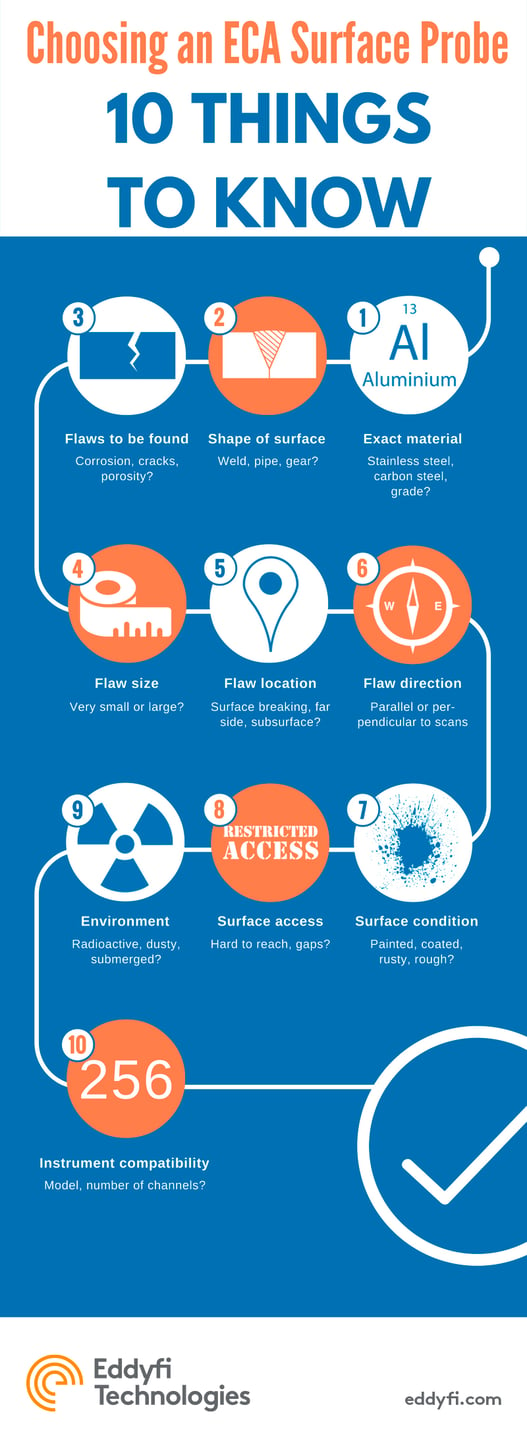Ten years ago (already!), we published a handy guide listing the main things that you need to know before you use, choose, or buy an eddy current array (ECA) probe for surface inspection. Considering the widespread growth that ECA has experienced in the last decade, and with the constantly evolving industries in which it is used, it is now time to review our guide and adapt it to today’s inspection reality. So, we asked ourselves the same question again: what information do we need to gather before choosing the right eddy current array equipment?
(Cover photo credits: victorcamilo via photopin cc)
1. What is the test material?
From zirconium alloys to graphite composites, ECA is usable on almost any conductive material. Knowing the exact composition, or grade, of the material is helpful. For example, different grades of stainless steel have their own specific electromagnetic properties: 400-series stainless steel is ferromagnetic while 300-series is not, and both contain exceptions. This can influence the configuration of the selected ECA probe and affect inspection results.
2. What is the geometry of the test surface?
Is the inspected surface perfectly flat or does it have strong curvature? What is the bend radius? Does it have uneven geometry? If there is a weld cap, how far is it protruding from the surface? Having access to a 3D model or to clear pictures of the surface can be of tremendous help when determining how flexible or how rugged a surface probe needs to be.
3. What types of defects are expected?
Cracks, corrosion, porosities, scabbing, hardening, lack of fusion, delamination… the list of potential integrity threats can be endless. But they all interact with eddy currents in their own unique way, and it may be beneficial to optimize some probe parameters, like the frequency and topology, based on the type of defect of interest.
4. What is the target flaw size?
ECA is a very sensitive technique when it comes to the detection of surface-breaking flaws. But in some applications, flaws below a certain target size don’t represent an integrity threat and may not need to be reported. To detect only the indications that are relevant, the coil sensors should be chosen based on an approximate target flaw size. From there, the coil size will dictate the resolution and surface coverage of the probe. This often makes the target flaw size the starting point of an entire probe design.
Speaking of size: is quantitative defect sizing required, or is detection enough? While ECA is mostly known for its detection performance, some probes like the Sharck™ and Sharck HR are built specifically for measuring the depth of surface cracks.
5. Where are the defects expected?
In non-ferromagnetic materials, ECA can detect flaws located on the near-side surface, far-side surface, or mid-wall. Knowing the expected location of the target defects relative to the component’s surface will help fine-tune the operational frequency and topology of the ECA probe to obtain the right amount of eddy current penetration. When penetration is necessary, knowing the wall thickness also becomes crucial.
6. What is the expected orientation of the defects?
Nowadays, most ECA probes can detect defects in all orientations, including axial, transverse, circumferential, and diagonal. But in applications where linear flaws are always expected with the same specific orientation, it may be beneficial to use a probe with channels in this preferential orientation only.
7. What’s the test surface condition?
Is the surface drenched in lubricant, covered with paint, epoxy, or rust, or does it have a high surface roughness? Knowing these details is essential and will dictate the type of contact interface to choose for the ECA probe. Surface condition also has an impact on the smallest defects that can be detected. Looking for very small defects on rough surfaces may require some compromises.
If the surface is coated, the characteristics of the coating will be just as important as those of the material itself since they will have a strong effect on the probe’s magnetic field. The nominal coating thickness, thickness variation, and coating material are three things that will need to be considered.
8. Is the test surface difficult to reach?
Is the surface in a restricted location, high up, or interspaced with gaps and supports? This can influence the shape and size of the ECA probe, making accessories such as poles or harnesses necessary, or require deploying the probe on an inspection crawler like the VersaTrax™ NDT.
9. In what type of environment must the probe be used?
Is the probe operating in a humid, dusty, or even radioactive environment? Is the probe used near welding equipment, near strong magnetic fields, or underwater? Is it used indoors or outdoors? Is the inspected surface kept at a very high – or very low – temperature? Is there easy access to a power source, a wi-fi network, or a cellular network? The environment will not only affect the choice of the probe, but also the instrument and its software.
10. What testing equipment is available?
Is the probe handled by a human operator, a robotic arm, or is it part of an automated inspection line? Is the data analyzed manually, or does a logical computer verify the presence of defects based on a go/no-go signal threshold? All these details, combined with the required number of eddy current channels, will determine the best probe and instrument model that should be used.

On top of these 10 questions, we suggest two favorite topics of any good project manager: budget and timeframe. Eddyfi Technologies’ ECA offering covers the full spectrum price range, from the single-frequency MIZ®-21C and advanced portable Reddy® to the almighty 256-channel Ectane® 3.
Similarly for lead times, our most common probes may be available off-the-shelf while very niche and custom equipment will first require some engineering work. Having a clear vision of a project’s budget and timeframe helps when selecting the right ECA equipment.
In conclusion, like with any modern technology, there is no such thing as a perfect ECA probe that can do everything. There will always be a choice to make when selecting or designing a probe, and the above list of questions can help pave the way towards the probe that is best tailored to your inspection needs. Eddy current array probes are now more versatile than ever, capable of inspecting a wide variety of applications and surface geometries, ensuring you find the perfect equipment for your needs.
View our entire product catalog with pricing on the Eddyfi eStore and get in touch with our experts to discuss your next inspection campaign!





